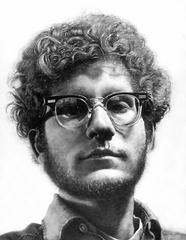Curriculum Materials: Art in America
|
|
Image 27 Chuck Close Questions: |
Think Questions
1. Do you think this is a flattering picture of Frank? Why or why not?
2. What did Close accomplish in this painting that he could not have accomplished in a photograph?
3. Why might Chuck Close paint his friend's PORTRAIT from a photograph rather than from life?
4. What makes this painting a PORTRAIT? What makes it more a painting of a photograph than a picture of an individual?
5. Although Chuck Close has said that he is interested in his subject's personalities, it is often hard to see this in the paintings. Why might he want to leave out information about the individuals he paints? How does the enormous size of this painting contribute to the depersonalizing quality? How does his mechanical technique contribute to this quality?
6. A writer once referred to portraits like this one as "giant face-scapes." What do you think he meant? Do you think this is a good way to describe Frank? Why or why not?
7. Many of the early paintings in this image set are very small. Where could you hang a small painting? The photographs in the set are relatively small. Where could you display a photograph? Frank is huge. Where could you display it? What does this say about developments in American art during the 1960s and 1970s?
8. Compare and contrast Close's painting Frank to Dorothea Lange's photograph Migrant Mother. Consider: SCALE, degree of focus, subject, etc. Then, compare and contrast Close's painting to Copley's painting Mrs. Nathaniel Allen. Do you think Close's PORTRAIT of Frank is more like Lange's portrait or like Copley's? Discuss.
|
|
